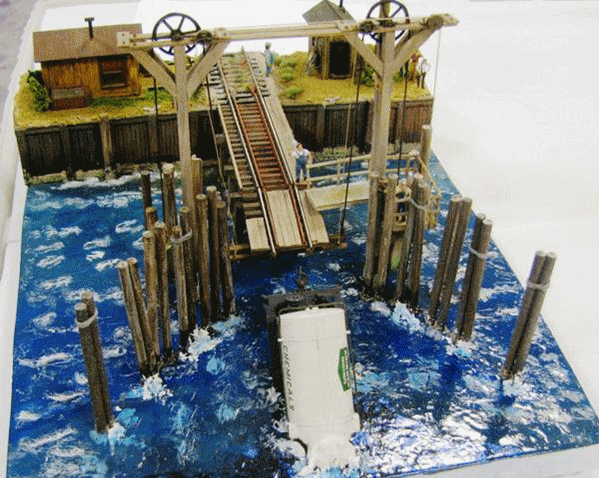July 2009, Volume 38 No. 11, Page 3
A Report on the SER Convention at Pensacola, Florida
Clint Smoke, Semaphore Editor
The weather and the hospitality were warm in Pensacola during our visit for the 62nd Conference of the SER of NMRA. The conference had the usual clinics, tours, contests, and banquet. Participation was off a bit, but for those attending, it was a good conference and it is a good year to be in Pensacola.
Pensacola’s History
Pensacola, Florida has a rich and colorful history dating back 450 years, being the first European settlement in the continental United States (1559) and controlled by five countries. Early exploration of Pensacola Bay spanned decades, with Ponce de León (1513), Pánfilo de Narváez (1528), and Hernando de Soto plus others charting the area.Due to prior exploration, the first settlement of Pensacola was large, with over 1,400 people on 11 ships from Vera Cruz, Mexico landing on August 15, 1559, led by Don Tristán de Luna y Arellano. However, weeks later on September 19, 1559, the colony was decimated by a hurricane which killed hundreds, sank five ships, grounded a caravel, and ruined supplies. The 1,000 survivors decided to relocate and resupply the settlement but, due to famine and attacks, the effort was abandoned in 1561. Pensacola was permanently reestablished by the Spanish in 1696 on the mainland, near Fort Barrancas, it was occupied by the French in 1719 but another major hurricane devastated the settlement in 1722, causing the French to evacuate, and the Spanish returned.
Pensacola's location has caused great turmoil, with many buildings destroyed by wars and by numerous major hurricanes. The location, south of the original British colonies, and on the dividing line between French Louisiana and Spanish Florida along the Perdido River, has caused the possession of the city to change multiple times. Pensacola has been under the possession of the Spanish, French, British, United States and Confederate States, and has remained a part of the United States since the end of the American Civil War. Along with wars, numerous hurricanes have been a massive factor in Pensacola history, destroying houses and leaving many people homeless.
Pensacola is nicknamed "The City of Five Flags" due to the five governments that have flown flags over it during its history: those of Spain (Castile), France, Great Britain, the Confederate States of America, and the United States. Other nicknames include "World's Whitest Beaches" (due to the white sand prevalent along beaches in the Florida panhandle), "Cradle of Naval Aviation" (the National Museum of Naval Aviation is located at the Pensacola Naval Air Station, home of the legendary Blue Angels), "Western Gate to the Sunshine State," "America's First Settlement," "Emerald Coast," "Redneck Riviera," and "Red Snapper Capital of the World."
Pensacola is a sea port on Pensacola Bay, which connects to the Gulf of Mexico. A large United States Naval Air Station, the first in the United States, is located southwest of Pensacola (near the community of Warrington) and is home to the Blue Angels flight demonstration team and the National Museum of Naval Aviation.
Pensacola is the westernmost city in the Florida Panhandle and the county seat of Escambia County. As of the 2000 census, the city had a total population of 56,255 and as of 2007, the estimated population was 54,283. However, the Pensacola–Ferry Pass–Brent Metropolitan Statistical Area, comprising Escambia and Santa Rosa counties, had a population of 453,451.
On February 19 of 2009, the King and Queen of Spain, Juan Carlos I and Sofía, took part in commemorating Pensacola's 450th anniversary, as America's first European settlement.
Pensacola Railroad History
The Pensacola and Atlantic Railroad was chartered on March 4, 1881 to connect Pensacola with the parts of Florida east of the Apalachicola River, across the sparsely populated Panhandle.The railroad company completed its surveys and began full construction on June 1, 1881. Official ground breaking ceremonies in Pensacola on August 22, 1881 brought into focus the importance of the West Florida enterprise and its evident relationship with the expanding Louisville and Nashville Railroad. The Louisville and Nashville Railroad was operating the original Alabama and Florida Railroad and subsequent Pensacola Railroad route into Pensacola from Flomaton Alabama, forty four miles to the north.
The Pensacola and Atlantic Railroad was constructed in less than two years' time with different sections of the railroad being built simultaneously by different contractors. The first Pensacola and Atlantic locomotive arrived in Milton in May 1882 by water and was placed in work train service constructing the railroad eastward from Milton. The first train over the newly constructed Escambia Bay Bridge arrived on August 15, 1882.
Upon completion of the Apalachicola River bridge west of Chattahoochee in February 1883, the river crossing at Sampson's landing was abandoned. Service from Pensacola to Jacksonville, Florida began the first week in May 1883 via connections with the Florida Central and Western Railroad, later Seaboard Air Line Railroad, at River Junction, Florida.
The Pensacola and Atlantic Railroad received financial backing from the Louisville and Nashville Railroad during construction and ceased operating as an independent line on July 1, 1885 when it was incorporated into the Louisville and Nashville system. Ninety seven years later in 1982, the Louisville and Nashville Railroad merged with the Seaboard Coast Line Railroad, Atlanta and West Point Railroad, Georgia Railroad, Western Railway of Alabama, and Clinchfield Railroad to form the Seaboard System Railroad. In 1985, the Seaboard system and the Chessie system merged to form CSX Rail System. The area is served by CSX today.
When the Pensacola and Atlantic was constructed through Northwest Florida in 1881-1883 the Florida panhandle was sparsely populated. The only two areas that warranted a depot were Milton and Marianna, Florida. Other depots were quickly added as people moved in to settle the wild lands and traffic began to increase. There were sixteen depots built in the first years.
Passenger service peaked in the 1920's with six trains a day calling at Milton. With the coming of the automobile and airplanes that were heavily subsidized by the government, passenger service started going into the red. Four trains survived until 1967 when the Louisville and Nashville along with other railroads lost the mail contracts. The remnant of the streamliner Gulf Wind, inaugurated in 1949 to replace steam powered heavyweight cars, survived until Amtrak's formation. Its last run was on April 30, 1971. The Gulf Wind's final years saw just token service consisting of one engine, one baggage car, one coach, and one sleeper with a diner between Jacksonville and Chattahoochee only. The service had been reduced to three times a week in an attempt by the Louisville and Nashville and the Seaboard Coast Line Railroad to cut costs and to help support the discontinuance petition filed with the ICC.
Beginning on April 4, 1993 Amtrak's "Sunset Limited" provided through service across Northwest Florida from Los Angeles, California to Miami, Florida via New Orleans, Louisiana, and Jacksonville, Florida with stops at Pensacola and Crestview. The "Sunset Limited" ended a twenty two year hiatus in passenger service across the Florida Panhandle. In August 2005, Hurricane Katrina destroyed the main line along the Louisiana and Mississippi Gulf Coast thus ending Amtrak's "Sunset Limited" and passenger service in northwest Florida.
Next month: Pensacola’s other railroad.
This year’s contest theme was something nautical to tie in with Pensacola’s rich nautical history.
| Several modelers had fun with this theme; here is one example |

|

|
One of many fine models that won Merit Awards at this year’s SER Conference. |
